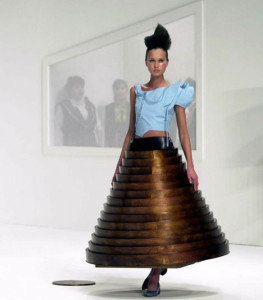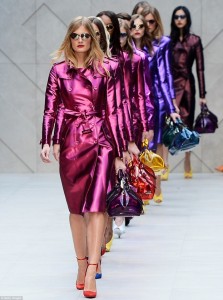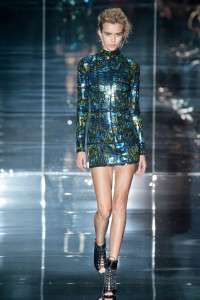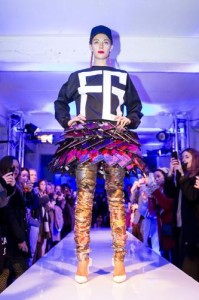As consumers increasingly become tech-savvy, brands need to innovate at the same pace if they want to survive. The fashion industry seems to be aware of this challenging scenario and London Fashion Week 2014 is a great demonstration of this evolution.
Especially this year, the event has become a technological exhibition as much as a fashion show. If we think that in 1984 the first LFW was hosted in a car park, it is easy to understand that the fashion industry has come a long way since then. Forget about the monarchy-inspired Harris Tweed collection, displaying corsets, tartans and crowns in 1987, or the wooden table-cum-skirt featured by Hussein Chalayan in 2000.
http://fashion.telegraph.co.uk/news-features/TMG6194975/25-years-of-London-Fashion-Week.html
The new fashion trends are a lot more futuristic now, keen to fit the digital age. For this season at Somerset House, catwalks abounded with metallized material with outer-space prints, technological fabrics like petrol plastic and metallic coated wool, 3D printed dresses, synthetic hair colour and textures, lit-up complexions and surreal effects on models skin.
In this revolutionary overview, Fyodor Golan’s collection stands out for autumn/winter 2014, presenting a £68,000 skirt made from 80 Nokia Lumia 1520 Smartphones, each releasing grasps of colored images, which, taken as a whole, give the illusion of one big picture. This image then changes when the model moves, mimicking the way the tone of a fabric tweaks when it moves back and forth from light to shadow.
However, the technological advancement of the fashion industry can be seen not only in the scientific mood of its garments, but also in the digital initiatives implemented during the show, which demonstrate a further engagement of brands with omnichannel innovation. With 60% of shows being live-streamed, technology has played a great role for some of the biggest international brands to promote new trends and styles. Thanks to the online broadcast promoted on YouTube, Twitter and Google+, the event has reached an audience of 4 million people, a great number compared to the 50,000 attendees registered before 2014. Apart from boosting the already high popularity of the show, the online buzz created around the event highlights a substantial shift from an idea of fashion as an exclusive topic in the hands of a few VIP editors, to a more social and democratized concept, where style and innovation can be influenced by social networkers and designers too.
More interesting data about London Fashion Week social buzz 2014 can be found in the following article:
Beside the social effort made by brand to capture the folk’s attention, some of the main fashion names have proved to be forward-thinking in every area of technology innovation.
Burberry, known for its avant-garde approach to marketing which includes strong digital and social media efforts, embedded digital chips into its apparels to reveal bespoke content when a smartphone was hovered over them. Similarly, Topshop teamed up with 3D agency Inition to offer its customers a virtual reality experience of its collection, including live personalisation of catwalk looks and customised video messages for members of the brand’s mailing list.
As Topshop former CMO, Justin Cooke, argued, “fashion brands who fail to embrace digital trends are likely to struggle to engage their customers in the future”, criticizing “slow-to-adapt retailers who are scared of multi-channel innovation”.
http://www.oresa.co.uk/london-fashion-week-embraces-multichannel-innovation/
I think it is fascinating the way the digital sphere is gradually becoming the overlapping bit between the fashion industry and people, which suggests the increased role of tech firms as great intermediaries between those brands and their customers.




